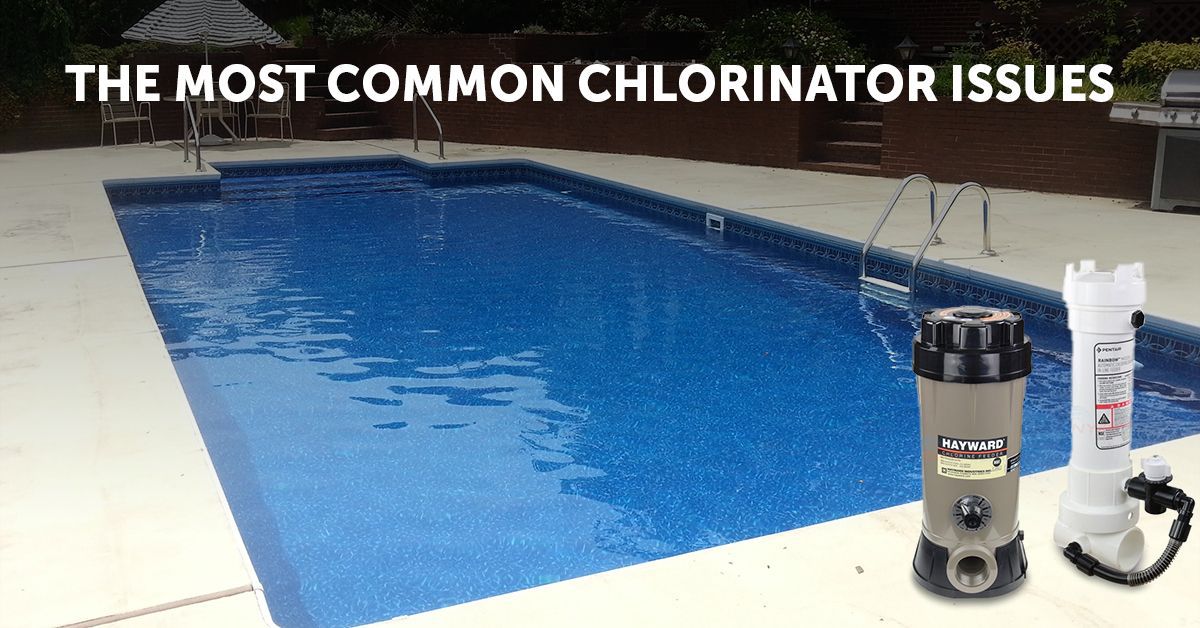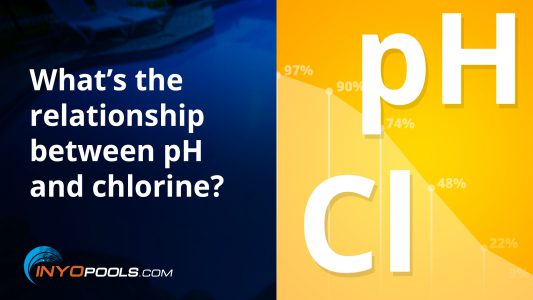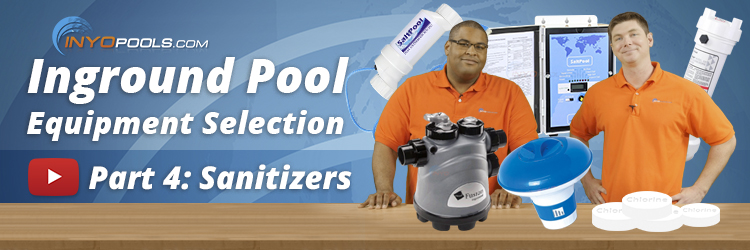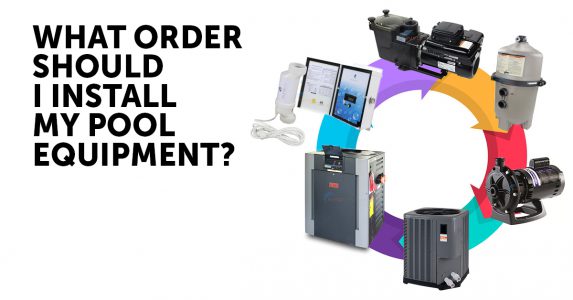Compared to other equipment, pool chlorinators are very straightforward to manage. Still, there are a few things that can go wrong during the installation and operation of your pool chlorinator.
In this article, we have compiled the most common swimming pool chlorinator issues and provide solutions that should help resolve the problem.
The Most Common Swimming Pool Chlorinator Issues
Before we begin, let’s make sure you know which type of chlorinator you have. There are two different types of chlorinators: inline and offline. The main difference between the two types of chlorinators is how you install it.
Offline chlorinators are ideal for pool owners installing a chlorinator into an existing pool line. You install them “off” of the existing plumbing line and attach thin tubes into the line.
On the other hand, you install inline chlorinators in line with your other pool equipment. This is a more permanent installation option and removes the need for additional tubing. There are no true benefits of installing one over the other. Truthfully, it depends on your current pool setup and what you have space for.
Tablets Are Not Dissolving
 One of the most common swimming pool chlorinator issues we encounter is the tablets not dissolving. Or, in some cases, they aren’t dissolving as quickly as you think they should.
One of the most common swimming pool chlorinator issues we encounter is the tablets not dissolving. Or, in some cases, they aren’t dissolving as quickly as you think they should.
However, pool owners can still come across other issues that contribute to undissolved chlorine tablets.
Solutions
Did you install your chlorinator correctly?
If your chlorinator has been working for some time now, you can probably exclude installation errors as the culprit. However, if it is a recent installation, we recommend beginning your search here. Offline chlorinators, especially, are prone to installation errors.
The direction of the hoses is especially important. Chlorinated water leaves the canister in a hose that connects to the main return line after the filter. However, if you reverse the hoses, the injection process that dissolves the chlorine will not function.
Look for directional arrows on the hoses showing the correct installation direction.
Did you set your output dial to 100%?
The output dial on the chlorinator controls the amount of chlorine you introduce to the passing water. Depending on the model, the dial setting ranges from 1 to 10. To increase the amount of chlorine that enters your pool, make sure you set the dial to 10, or the maximum.
Do you have a clogged control valve?
Sometimes, you might forget to close the control valve before you vacuum your pool. However, when this happens, there’s a chance that the passing debris can lodge itself inside of the valve. This reduces the flow going through the chlorinator and can cause your chlorine levels to drop.
To clear the valve, first, remove the chlorinator lid. Using tongs, remove the chlorine tablets from the canister. Next, using tongs, remove any sludge or debris at the bottom of the chlorinator. Finally, remove the screen and hose it down with water.
However, if this does not solve your problem, you may need to replace the control valve.

My Chlorinator Lid is Tight, Leaking, or Won’t Fit Properly
Whenever you have a leak, the first places you want to check are the gaskets and O-rings. The O-ring on the inside of the chlorinator can become brittle over time.
Solutions
If your chlorinator is leaking or you’re having difficulty closing the lid, we recommend replacing your O-ring. While the lid is off, we recommend checking for calcium deposits. Over time, small calcium deposits can form. If so, you can remove the deposits with a small screwdriver.
Also, it’s always good practice to lubricate your O-ring. This is an easy preventative step you can add to your maintenance routine to prevent future leaks. Lastly, if you have a crack in the lid, replace it. You can find replacement parts for your chlorinator by identifying the make and model.
Airlocks
Air can enter your system from anywhere in the pool line and ultimately end up in your chlorinator. An airlock inside your chlorinator can reduce both water flow and chlorination.
Solutions
You can actually check your chlorinator for an airlock yourself. First, turn your pump off and remove the chlorinator lid. Low water in the canister indicates the presence of air. Next, restart the pump while the lid is off and allow water to fill the canister. As the water rises, it will push the air out of the system.
Once the water fills the chlorinator, you can reinstall your lid.
Your Issue Not Covered?
Although these are the most common swimming pool chlorinator issues we encounter, we certainly believe there are more out there. If you are experiencing an issue with your chlorinator that we haven’t discussed, please send us an email or leave a post in the comment section.












Inline chlorinatior has only 2 operating positions fully closed or fully open will not adjust between the two
When I open chlorinator there is an overwhelming chlorine smell and I have to walk away. Tablets appear to be dissolving. I’m not sure what’s going on?
If you open a functioning chlorinator, you’re going to smell chlorine. Just like if you put bread in a toaster, you’ll smell toast. Also, you should never breathe in chlorine fumes; it’s dangerous.
Tablets are meant to dissolve into solution,, it’s how chlorinators work.
I have a Hayward Automatic Chlorinator that is hooked up with the in going before the filter and the out going to the pool return. I tested the water, there is no chlorine registering on the test strip. What can be wrong?
Going by the basic explanation, it could be anything. It could be the chlorinator, water chemistry, or the test strips could be fouled.
What are the results of your latest pool chemistry test? You need to include results for pH, Alkalinity, and Calcium.
Is your water cloudy, green, or clear?
Free chlorine on last test at my pool supply store was 0.13, total chlorine 1.35, pH 8.0. Stabilizer was low. I adjusted the pH, and then 4 bags of shock and stabilizer. Chlorinator is filled with Chlorine. Still, 3 days later, test strips are not registering any chlorine. Test strip shows no chlorine, pH is fine, alkalinity is fine, Stabilizer is low!. Just so you know, we recently replaced our Hayward motor and Hayward Chlorinator. There is a noise like marbles which I think is the impeller. I have purchased new seals from you but have not installed them. Do you think this is the problem with not having enough power to push the water through the chlorinator?
Gaskets and seals cause water leaks or air in the system, which prevents priming. Unless your system shows signs of those things, the gaskets aren’t the problem. Also, if you hear strange sounds from the pump, you must check for any debris or impeller damage.
You state that the stabilizer level is low twice, but why haven’t you added cyanuric acid? Chlorine requires a stabilizer to prevent sun burn-off, which zaps a portion of your chlorine before it can do anything.
Pool shock contains no stabilizer, and the chlorine tablets have stabilizer but not enough to compensate for CYA levels that are already low.
Read this article – How To Break Chlorine Lock
Hello,
I have a Sami King Performax chlorinator. Installed 10 years ago with pool. The past week, I am not detecting chlorine on test strips or little blue box kit. Yet, it’s working slightly because the tablets are semi dissolved. I checked your site and did the following:
Took lid off and turned pump on to fill with water, then put lid on and bled the air from the top valve.
Still didn’t do it…
Removed tablets and pulled screen out – no debris clogging it
There is a small amount of fine sand stuff on bottom but nothing crazy.
So, wondering if control valve needs to be replaced – we already replaced the lid a year or two ago.
Any help would be appreciated.
Thank you!
My chlorinator which I think is a Hayward is full of water and overflowing. How do I correct this?
First, what type of chlorinator is it? Is it a basic tablet feeder that sits on your plumbing line? Or is it some other kind? A model number from the tag would help
What do you mean by overflowing? Is it leaking while the pump is running? Or is overflowing referring to something else? Please be specific.
I’m being told by our pool maintenance team that the chlorinator isn’t working properly. How will I know if it’s fixed? Is it just a matter of checking the chlorine levels to see if they’re improved the next day? Thanks.
In short, yes. Chlorinator has one job, to chlorinate the pool. If the thing that is broken about it is that it isn’t producing chlorine, seeing a rise in chlorine levels in the water would be the best sign it is back online.
My offline chlorinator is leaking through the inlet and outlet hoses connecting to the unit. I cannot figure out what is causing this. When I increase the flow the leak increases. Do you know what this issue is and how to fix it?
First, what is the make and model of your chlorinator? It is important to know this as not all chlorinators are designed the same.
If the leaking increases when you increase the flow of water to the chlorinator I would say either a clamp or threads aren’t secure enough. if there is a union or clamp near the points of the leaks I would start by tightening those.
I feel like my CL220 off line chlorinator is NOT working correctly. When I turn the control to OFF the tabs inside will still disappear in a matter of a few days. On a chemical check my FC is crazy high. What part might be defective and need replaced?
I have a Compupool Model CPX 36. When I power up the unit, the display show “Compupool CPX Series, then immediately show SW VER 01.0.13. None of the control buttons have any effects on the unit. I have been able to find any information as to what this code mean. Can you please help me.
Please warn people about possibility of an explosion with inline chlorinators. This just happened to me, fortunately I was on the opposite side that blew off & no children or pets were on the other side as they would have been seriously injured or killed. I was actually removing the chlorinator from the line by cutting the pvc tubing. I cut the tubing on the pool side then immediately went to cut the other side & BOOM! The pool pump had been off for 24hrs (contained about four 3” tabs) while I replaced the pump & starting my upgrade to salt chlorinator. Wish I knew why that happened.